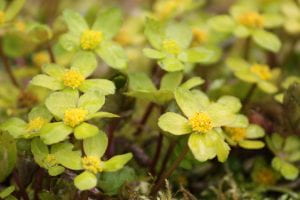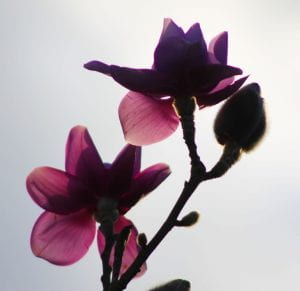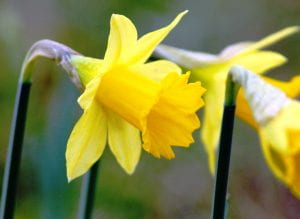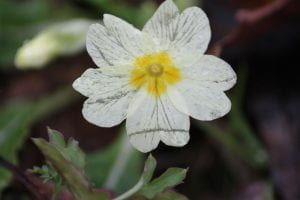By Andy Winfield

It’s been a wet winter; it started raining in September and doesn’t seem to have stopped. I’m typing this with the sound of raindrops drumming against the glass of our Propagation House, a familiar tune this year. The ground is saturated, and the trees have lost a few branches here and there from the strong weekend winds that have been the theme of this February. Despite it all, Spring is gamefully peering through the rainy curtains to see if it’s safe to start, and there are a few punctual arrivals that are bringing smiles to our rain soaked faces.
One of my favourites is a small plant that grows in European woodlands; Haqceutia epipactis emerges from the mossy ground with lime green bracts surrounding very small yellow florets. It’s a plant anyone could easily walk past without a second glance, but when you stoop to look at it you notice the intricate and unusual beauty. Some plants have many names, their botanical name and a number of names bestowed by communities, culture and history. I feel a bit for this lovely plant, it is only known as Hacquetia, named after an Austrian botanist; and epipactis seems to have a link to milk curdling properties. For me this is a plant that makes me happy to see it, so we’re giving it a common name of our own, the ‘shady daisy’.

There is another plant that is brazenly stepping into springtime at the moment, turning heads throughout the Garden. Rising up to the rain with dinner plate sized flowers is the catchily named, Magnolia campbellii subsp. mollicomata ‘Lanarth’; its brightness is incongruous to the surrounding gloom. Watching visitors faces as they look up to the confident blooms shows the impact that plants have on a mood; you can’t help but smile at this plant, like a holidaymaker wading into the sea because they’re not letting a bit of rain ruin their holiday, this magnolia isn’t going to let a bit of rain ruin it’s spring show and that makes us love it all the more.
 Bright cheerful daffodils are popping up on banks, woods and lawns; in recent years they’ve had to flower during eastern beasts and late winter icy blasts, so emerging into warm westerly rain will be a welcome change for them. The trumpets of a daffodil face the ground much like Narcissus himself, the Greek hunter from mythology who fell in love with his own reflection in a pool and so couldn’t move from that spot. Although the daffodil’s botanical name is Narcissus, they are not named after the self-gazing Greek influencer, the name actually derives from the Greek narkissos meaning numbness; this relates to the toxicity of the plant. Daffodils are poisonous; if you put any other flowers in a vase with a daffodil they will quickly die. You also might notice that squirrels and deer won’t eat daffodils knowing it won’t do them any good; there have been instances of people buying sprouting daffodil bulbs and mistaking them for chives, an uncomfortable mistake. This plant has developed a little warning to potential eaters by tasting disgusting, so ingesting the large amounts needed to do serious damage would need meaningful commitment.
Bright cheerful daffodils are popping up on banks, woods and lawns; in recent years they’ve had to flower during eastern beasts and late winter icy blasts, so emerging into warm westerly rain will be a welcome change for them. The trumpets of a daffodil face the ground much like Narcissus himself, the Greek hunter from mythology who fell in love with his own reflection in a pool and so couldn’t move from that spot. Although the daffodil’s botanical name is Narcissus, they are not named after the self-gazing Greek influencer, the name actually derives from the Greek narkissos meaning numbness; this relates to the toxicity of the plant. Daffodils are poisonous; if you put any other flowers in a vase with a daffodil they will quickly die. You also might notice that squirrels and deer won’t eat daffodils knowing it won’t do them any good; there have been instances of people buying sprouting daffodil bulbs and mistaking them for chives, an uncomfortable mistake. This plant has developed a little warning to potential eaters by tasting disgusting, so ingesting the large amounts needed to do serious damage would need meaningful commitment.
Primroses dot the grassy areas of the Garden, unhindered by rain. Their name is synonymous with early springtime deriving from Latin prima rosa, the first flower, a symbol of the slow cracking of winter’s hard shell. The light will change quality in March and we’ll be dashing out into the warm sun, t-shirts on, before getting caught out by the chilly shade and freezing evening; more plants will flower, blossom on trees and bulbs on the ground. We may receive a blast or two of cold air in the next few months, but the Garden’s acceleration to spring and summer is unstoppable now.
By Andy Winfield



Loved Andy Winfield’s beautifully written piece on ‘Irrepressible Spring’ – it made me smile and caught the mood just right: we’re on the way out of winter. Thank you.
Thank you Liz, we’ve passed that on.
Interesting to know the origins of some of those flower names!